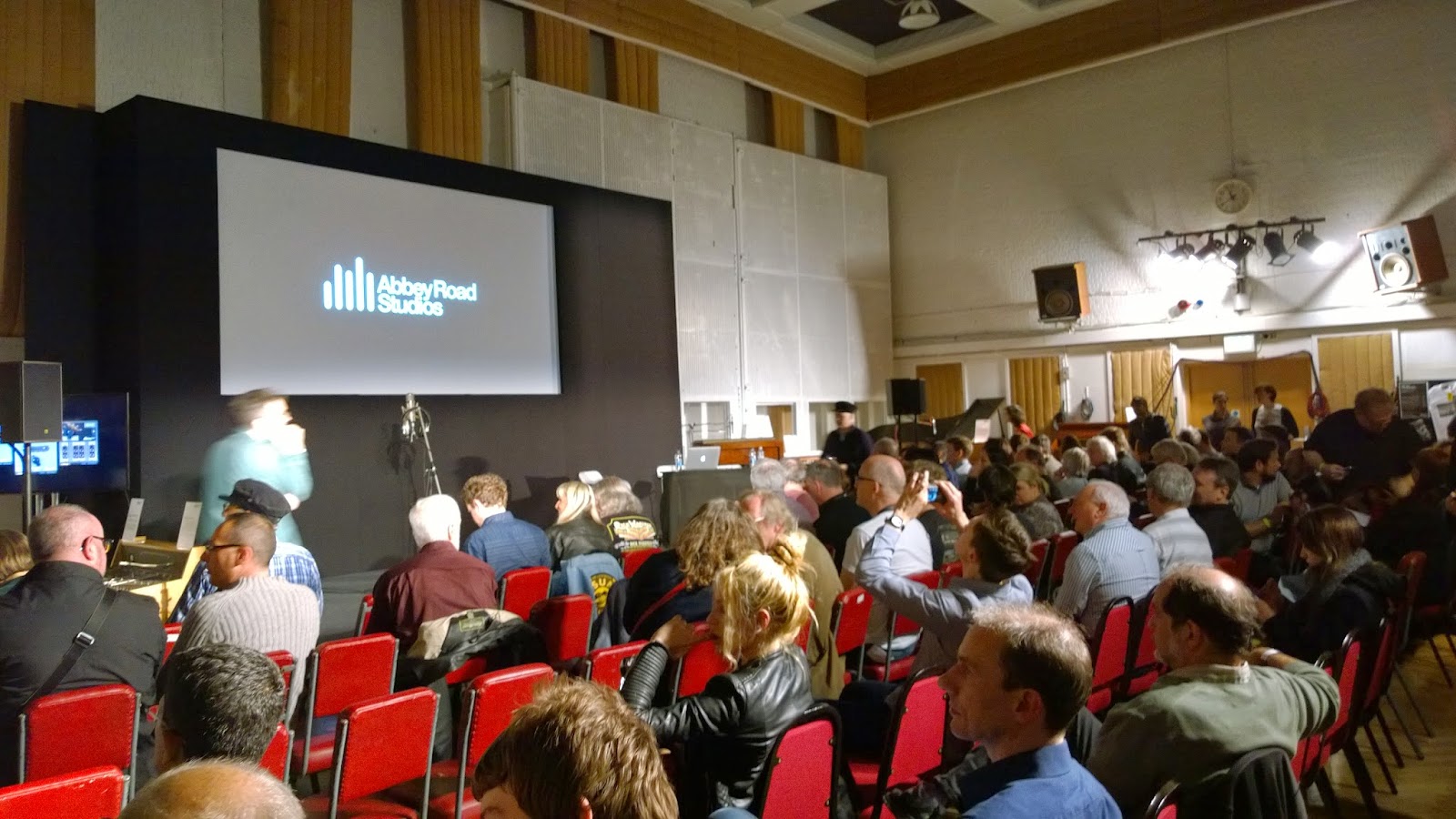Why did I even have my doubts?
Upon getting to the studios, I was out of breath from running through St. John's Wood to get there on time. The guys up front assured me I was on time and that the talk hadn't begun. As directed, I walked through a hall and down a staircase decorated with various black and white images of musical legends recording in Abbey Road -- from The Beatles to David Bowie to Oasis. At the bottom, I made a right and entered the legendary Studio Two.
The studio was set up with seats for around 120 people. Although everyone was talking to each other in hushed tones, you could feel the excitement. I took a seat in the back and looked around. The crowd seemed to skew older than myself and also seemed to be more men than women; I was certainly one of the few people there alone.
The hosts were Brian Kehew and Kevin Ryan, authors of the book Recording the Beatles with guest Ken Scott, who was an engineer that worked with The Beatles. The talk actually revolved mostly around Abbey Road Studios and its contribution to musical history and the developments of recording technology, like the development of stereo, how master recordings were made, and the differences between the three studios in Abbey Road. Of course, The Beatles played an enormous role with their experiments and pushing the boundaries of what was feasible. I don't actually have any sort of photos or recordings of the talk itself because it was forbidden since Kehew, Ryan, and Abbey Road Studios wanted to keep the content exclusive, which I can fully understand.
When Ken Scott talked, he mostly described how it was working with The Beatles, how he accidentally wound up as an engineer, and had lots of fascinating little anecdotes. For example, the snare drum hit on the song "Glass Onion" in the beginning and in the middle are two completely different ones though they were supposed to be the same. He tried so hard to get the recording right, and it just didn't work. The Beatles didn't really care. Or how he made some off-hand comment about recording in a small closet off Studio Two and two days later, The Beatles decided to record "Dig a Pony" in it, which gave it a very enclosed, tight sound. To say the least, I was hanging off every word he said.
The highlight of actually being in Abbey Road Studio Two, though, was listening to music in the actual studio. Naturally, being the most famous recording studio in the world, they had amazing speakers there and the acoustics were fantastic. A small clip of The Beatles' version of "Twist and Shout" was played and it was incredible. The sound was so clear and crisp that it was like being in the studio with them. I could just imagine them standing in the corner going wild recording the song. In the photo above, that's the corner where they always stood. And this is their point of view of the studio:
In addition to listening to clips, Kehew and Ryan asked the audience if anyone played piano (my reaction: "Dammit, why didn't I ever learn to play piano instead of trumpet?!"). They took three people and sat them down on a few pianos they had (see image below). These pianos are always in Abbey Road Studios and they have different timbres. One dating from 1905 has an exceptionally bright sound that would be great for ragtime and Paul McCartney had used it for "Ob-la-di Ob-la-da." The famous Steinway was also in the corner. These three lucky people were instructed by Kehew and they simultaneously struck a very, very famous chord -- the chord at the end of "A Day in the Life." The sound reverberated throughout the studio, slowly faded out, and I'm sure I'm not the only one who got chills. I could just imagine John Lennon, Paul McCartney, Ringo Starr, Mal Evans, and George Martin all playing this at the end and letting it ring, so much so that you can hear Ringo's chair squeak ever so slightly in the remastered version. Nobody had to be told what the chord was; everyone recognized it immediately.
At the end, there was a chance to buy some merchandise (like the books from the speakers, which we could get signed) and walk around Studio Two. They had some old equipment to look at, like old sound boards and the various pianos. It was really super interesting.
The ability though to be in the place where The Beatles recorded all of their albums, to be able to listen to their music in the place where they were, to hear Ken Scott's stories about working with The Beatles, was worth every cent. It was a truly remarkable experience and I am so glad I was able to do it. Even hearing about how technology developed in Abbey Road Studios was fascinating and it's definitely given me a better appreciation of music in general.
Lastly, I think this picture basically says how ecstatic I was after the talk:




No comments:
Post a Comment